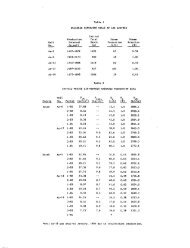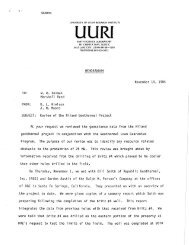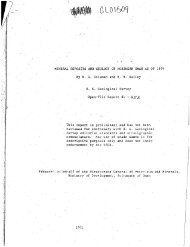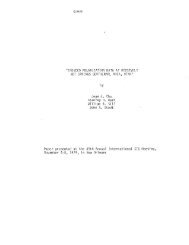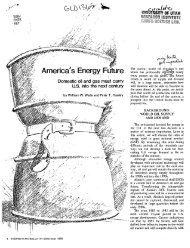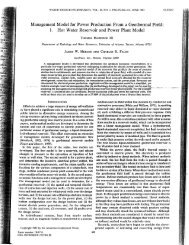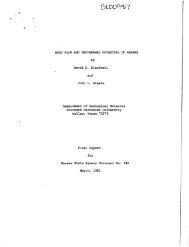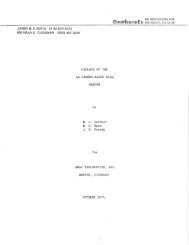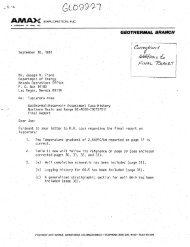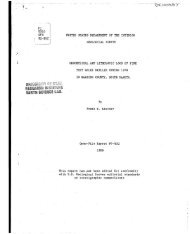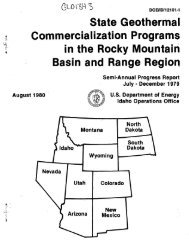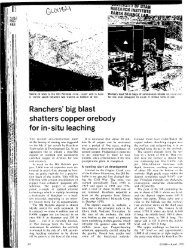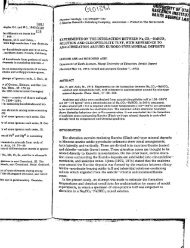Figure I Generalized map of the Wilbur Mining ... - University of Utah
Figure I Generalized map of the Wilbur Mining ... - University of Utah
Figure I Generalized map of the Wilbur Mining ... - University of Utah
Create successful ePaper yourself
Turn your PDF publications into a flip-book with our unique Google optimized e-Paper software.
Geotiiermal Resources Council, 'Ili'UiSACTIOiiS, Vol. 3 September 1979<br />
AN ANALYSIS OF GRAVITY AND GEODETIC CHANGES DUE TO RESERVOIR DEPLETION<br />
AT THE r.EYSERS, NORTHERN CALIFORNIA<br />
Roger P. Denlinger, William F. Isherwood, and Robert L. Kovach<br />
ABSTRACT<br />
In this paper gravity and geodetic data are<br />
combined with reservoir engineering studies to<br />
place upper and lower bounds on <strong>the</strong> volume and<br />
pore fluid mass changes within <strong>the</strong> depleted portion<br />
<strong>of</strong> che steam reservoir at The Geysers. We<br />
combined <strong>the</strong> gravity and temperature data to<br />
constrain <strong>the</strong> changes in pore fluid mass distribution<br />
due to fluid depletion, and thus<br />
limited <strong>the</strong> drainage volume to lie between 15<br />
and 25 cubic kra. We <strong>the</strong>n modeled <strong>the</strong> surface<br />
geodetic data to determ.ine values <strong>of</strong> strain<br />
between 3. and 8. X 10"^ for <strong>the</strong>se drainage<br />
volumes. We determined that this strain could<br />
be induced ei<strong>the</strong>r mechanically or <strong>the</strong>rmally,<br />
and <strong>the</strong>re 'is presently no way <strong>of</strong> distinguishing<br />
<strong>the</strong>rmal from mechanical strain.<br />
Since 1974, <strong>the</strong> average production rate at The<br />
Geysers steam field in Nor<strong>the</strong>rn California (<strong>Figure</strong><br />
1) has been nearly 90 million kg <strong>of</strong> steam per day<br />
(Lippman and o<strong>the</strong>rs, 1977). This large fluid<br />
withdrawal rate has caused changes in mass and<br />
volumetric strain within <strong>the</strong> depleted reservoir<br />
volume. From 1973 Co''1977, time changes in pore<br />
pressure, surface strain (L<strong>of</strong>gren, 1979), and<br />
gravity (Isherwood, 1977) occurred, while <strong>the</strong><br />
reservoir•temperature did not measurably change.<br />
In this paper, <strong>the</strong> gravity and geodetic data<br />
from 1974 to 1977 are combined with reservoir<br />
engineering results (VJeres, 1977) to determine <strong>the</strong><br />
pore fluid deficit and strain within <strong>the</strong> drainage<br />
volume. Previously, (Isherwood, 1977; Hunt, 1977)<br />
it has been demonstrated that decreases in observed<br />
gravity with time reflect mass redistribuCion and<br />
deficits within some depletion volume. By comparing<br />
<strong>the</strong> total mass deficit measured from <strong>the</strong><br />
gravity flux (found be integrating <strong>the</strong> gradient <strong>of</strong><br />
<strong>the</strong> potential over some bounding surface) with <strong>the</strong><br />
net mass produced, <strong>the</strong> recharge was estimated<br />
(Isherwood, 1977). Here we combine <strong>the</strong> gravity<br />
changes with well data to constrain <strong>the</strong> drainage<br />
volume between 15 and 25 cubic km. Wc <strong>the</strong>n<br />
analyzed <strong>the</strong> geodetic data to determine <strong>the</strong><br />
reservoir strain within <strong>the</strong> possible range <strong>of</strong><br />
reservoir voluraes. These concepts are summarized<br />
in Table 1.<br />
At The Geysers, <strong>map</strong>ped values <strong>of</strong> maxima in<br />
subsidence, gravity change, pore pressure decline<br />
overlap. <strong>Figure</strong> 2 compares <strong>the</strong> decreases in observed<br />
gravity and pore pressure decay due to<br />
U.S. Geological Survey<br />
Menlo Park, CA 94025<br />
153<br />
steam production. Isherwoods' (1977) previous<br />
analysis <strong>of</strong> this data determined that (1) <strong>the</strong><br />
gravity changes were too large to be due solely<br />
CO a deep water table below <strong>the</strong> producing zone<br />
penetrated by <strong>the</strong> wells, and (2) <strong>the</strong> gravity flux<br />
implied a mass deficit equal to <strong>the</strong> met mass produced,<br />
suggesting negligible recharge.<br />
The lack <strong>of</strong> a measurable temperature change<br />
(plus or minus 3 degrees Celsius) limits <strong>the</strong><br />
araount <strong>of</strong> water which has flashed to sCeam during<br />
production to less than 0.5% <strong>of</strong> <strong>the</strong> bulk rock<br />
volume. Yet reservoir engineering data imply thac<br />
water flashes to steam to supply <strong>the</strong> fluid produced<br />
by <strong>the</strong> wells (Weres, 1977). Since <strong>the</strong> heat<br />
energy required in <strong>the</strong> phase transition from water<br />
to steam must come from <strong>the</strong> rock matrix, <strong>the</strong> lack<br />
<strong>of</strong> a measurable temperature change limits <strong>the</strong><br />
change in reservoir liquid content due to steap<br />
production to that allowed by <strong>the</strong> error in <strong>the</strong><br />
temperature measurements (Weres, 1977; Denlinger,<br />
1979). The steam could come from a deep water<br />
table in this case, but this is inconsistent with<br />
<strong>the</strong> magnitude <strong>of</strong> <strong>the</strong> time changes in <strong>the</strong> gravity<br />
mentioned above.<br />
9 lp20»4O90«07DaaK«<br />
I—I I I—1—I I I I<br />
<strong>Figure</strong> 1. Index <strong>map</strong>, showing <strong>the</strong> region <strong>of</strong> discussion in<br />
this paper.



